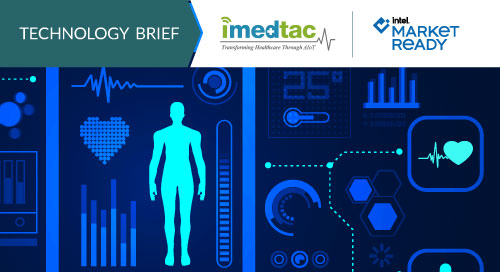Fill form to unlock content
Error - something went wrong!
Your content is just a step away. Please submit below.
Thank you!
IoMT Automates Vital Signs Technology

No one likes to schedule a medical appointment only to find an endless wait at a crowded doctor’s office or clinic. But with a critical lack of healthcare workers, those waits aren’t getting any shorter. The good news is IoMT (Internet of Medical Things) technology helps take the pressure off overburdened staff. AI-enabled self-service kiosks can deliver a better patient experience—both in and out of the clinical setting.
Shortage of medical professionals may be new in some parts of the world, but it’s a familiar problem in other markets.
“Asian hospitals have faced staffing issues for a long time,” says Jason Miao, Overseas Business Sales Director for Imedtac Co., LTD, a provider of IoMT technology solutions. “Here in Taiwan, it’s not uncommon for a doctor in a public hospital to see 100 patients in a three-hour shift.”
When you practice medicine at that kind of scale, one important truth becomes apparent: Anything that optimizes workflows in hospitals and clinics is a win.
As Imedtac’s Business Development Manager Beren Hsieh puts it: “It might not seem like a dramatic change, but if you can use technology to improve a process by a few minutes per patient, it has a huge impact on wait times and provider availability.”
“If you can use #technology to improve a process by a few minutes per #patient, it has a huge impact on wait times and provider availability.” – Beren Hsieh, Imedtac Co., LTD via @insightdottech
AI in Healthcare Makes It Easier to Measure Vital Signs
Case in point: Imedtac’s Smart Vital Signs Station, an IoMT alternative to the traditional vital signs measurement workflow.
The vital signs monitoring system is a self-service kiosk that measures a patient’s height, weight, temperature, heart rate, and blood pressure. If desired, it can be configured to record additional vital signs, such as blood oxygen levels.
The traditional method of measuring a patient’s vitals requires a trained individual to take readings, with varying devices, and manually record the results. On the other hand, Imedtac kiosk is a one-stop, self-service, automated solution that can save valuable time and resources.
Patients begin by identifying themselves to the system, which is connected to the hospital’s health information system. The station then measures other relevant health data their height, weight, temperature, and so on, providing guidance as needed through a simple-to-use interface. It automatically uploads the results to the cloud so that the patient data can be securely integrated with the patient’s electronic medical record and personal health record.
The entire process takes just a few minutes. Crucially, healthcare providers don’t need to be involved at all—freeing them up to perform other duties, and preventing errors caused by the manual transcription of vitals data (Video 1).
IoMT Devices Support Flexibility and Stability in Rural Thailand
Solutions like Imedtac’s need to operate in a wide variety of settings, from hospitals, clinics, and healthcare organizations to neighborhood pharmacies, gyms, and even grocery stores. Understandably, there isn’t always a lot of support or oversight available. For this reason, they are designed for flexibility, stability, and ease-of-use. The company’s experience in northern Thailand is a good example.
Imedtac partnered with Overbrook Hospital in Chiang Rai, a small city in a rural part of the country that serves as a medical hub for the surrounding communities. It was a challenging deployment. Overbrook is a busy hospital, where doctors and nurses are stretched thin, and IT resources are not as readily available as in larger urban centers. The hospital’s patient base presented an additional issue because it included many elderly patients as well as people unaccustomed to using technology in their daily lives.
Imedtac worked with Overbrook’s administrators to develop an optimized patient intake workflow—one tailored to the hospital’s needs. To cope with limited English proficiency in the region, they added a Thai language user interface. And to simplify the authentication process, they included support for Thai national ID cards. Imedtac’s developers then integrated the kiosks with the hospital’s legacy IT systems.
The results were better than expected. As it turned out, the majority of patients caught on to the vital signs stations very quickly, and were able to use them without difficulty. The hospital’s nurses, who no longer had to measure each patient individually, were free to assist those who required extra help.
The deployment in Overbrook has also proven to be very reliable—important in any hospital setting, of course, but especially in one where IT resources are limited. Here Miao credits Intel® processors: “These vital signs kiosks run 365 days a year, pretty much nonstop, so they have to be built on something dependable. Intel provides an extremely stable and powerful platform for IoMT applications.”
The Future of Patient Care
IoMT technology is already providing some much-needed relief to healthcare professionals. Going forward, it may be able to directly improve health outcomes for patients as well. “Near term, we’re already starting to see solutions like smart wards, which use edge AI and real-time analytics to optimize inpatient workflows and improve medication safety,” says Hsieh.
Further ahead, healthcare administrators and systems integrators will turn to edge analytics and AI to enhance remote patient monitoring, critical care, and surgical medicine.
“In the future, this technology will be used to integrate data streams for ICU and OR staffs, giving them the information they need when they need it,” says Maio. “And doctors will rely on AI to help them make better decisions about patient care.”
Many challenges remain for the healthcare industry, both now and in the coming years. But thanks to advances in IoMT technology, the prognosis is improving.
This article was edited by Christina Cardoza, Editorial Director for insight.tech.
This article was originally published on May 19, 2022.